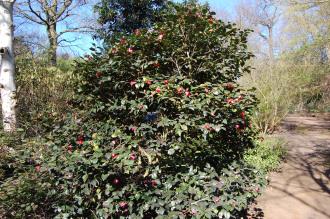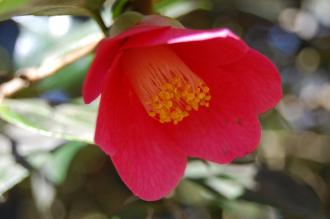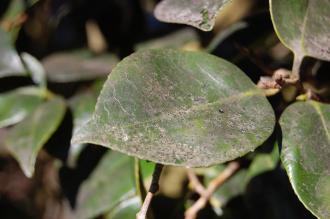
Camellia japonica (16/03/2014, Kew Gardens, London)
Position: Dappled to full shade
Flowering: Late winter to early spring
Soil: Moist, well-drained, acidic
Eventual Height: 4m
Eventual Spread: 4m
Hardiness: 6b, 7a, 7b, 8a, 8b, 9a, 9b
Family: Theaceae
Camellia japonica is an evergreen winter flowering shrub with a bushy habit. Its dark green leathery leaves are ovate with serrulate margins and a cuneate tip, paler on the underside, up to 11cm long and 6cm broad. Its young branches are purple/ brown becoming gray with age. Its deep pink flowers have protruding yellow stamen are up to 10cm across and appear along the branches, particularly at the ends. The fruit consists of a three compartmented globe shaped capsule which has a diameter of up to 2cm.

Camellia japonica Flower (16/03/2014, Kew Gardens, London)
Camellia japonica, commonly know as Japanese Camellia or Rose of Winter, is native to Japan, Korea and China. In it native habitat it grows as an understory plant in forests. This plant should be positioned in a site sheltered from cold, dry winds and early morning sun as buds and flowers may be damaged by cold winds and late frosts.
The etymological root of the binomial name Camellia is derived from and named after the botanist George Kamel. Japonica is derived from the Latin for Japan as it was first discovered there by Engelbert Kaempfer in the eighteenth century.
The landscape architect may find Camellia japonica useful an evergreen, late winter flowering shrub which will tolerated shaded conditions and acidic soils.

Camellia japonica Leaf (16/03/2014, Kew Gardens, London)
Ecologically, Camellia japonica is of little wildlife value in the UK.
Camellia japonica prefers moist, humus rich, fertile, well-drained soils. It prefers neutral to acidic soils.
Camellia japonica requires little maintenance. If necessary, pruning should be carried out after flowering.

